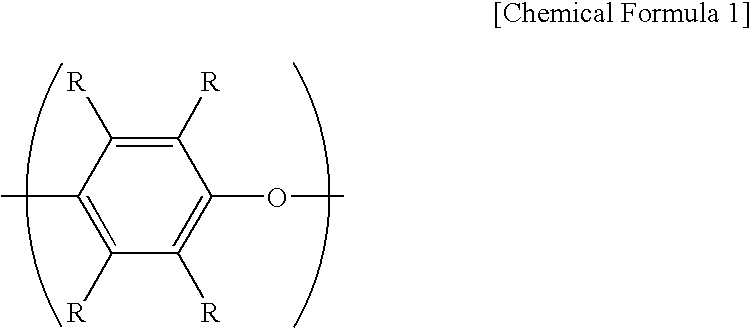Polyamide-polyhenylene ether resin composition
- Summary
- Abstract
- Description
- Claims
- Application Information
AI Technical Summary
Benefits of technology
Problems solved by technology
Method used
Image
Examples
examples
[0145]Hereinafter, the present invention will be described further in detail by referring to Examples and Comparative Examples, but the present invention is by no means limited to those described in these Examples.
(Materials Used)
(1) Polyamide 6,6 (Hereinafter Abbreviated as PA)
(1-1) Polyamide 6,6 (Hereinafter Abbreviated as PA-1)
[0146]With a 50% by weight aqueous solution containing 1,600 kg of a polyamide 66-forming component (an equimolar salt of hexamethylenediamine and adipic acid) were blended 828 g of acetic acid and 828 g of hexamethylenediamine as end-blocking agents. Furthermore, 394 g of a 10% by weight aqueous solution of sodium hypophosphite (NaH2PO2) and 55 g of a silicone defoaming agent were blended therewith to prepare a mixed solution. The mixed solution was charged into a concentration vessel, followed by mixing under a temperature condition of about 50° C. and replacement with nitrogen. Then, the temperature of the mixed solution was elevated from about 50° C. to...
examples 1 to 12
, Comparative Examples 1 to 3
[0198]Pellets of resin compositions were prepared by using a twin-screw extruder [ZSK-40: manufactured by Coperion Corporation (Germany)] having the upstream feed port on the first barrel from the upstream side of the extruder, the downstream feed port on the sixth barrel, and an L / D (the cylinder length of the extruder / the cylinder diameter of the extruder) of 44 (the number of barrels: 11) under the following operating conditions. The temperature from the upstream feed port to immediately before the downstream feed port was set at 320° C., and the temperature from the downstream feed port to the die was set at 280° C. The screw speed was 300 rpm, and the discharge was 60 kg / hr. PPE, SEBS, GPPS, and MAH were fed from the upstream feed port and melt-kneaded and then PA and NaH2PO2 were fed from the downstream feed port so that the proportion as described in Table 1 was obtained. The resulting resin compositions were adjusted for water content and then ev...
PUM
| Property | Measurement | Unit |
|---|---|---|
| Temperature | aaaaa | aaaaa |
| Weight | aaaaa | aaaaa |
| Fraction | aaaaa | aaaaa |
Abstract
Description
Claims
Application Information
 Login to View More
Login to View More - R&D
- Intellectual Property
- Life Sciences
- Materials
- Tech Scout
- Unparalleled Data Quality
- Higher Quality Content
- 60% Fewer Hallucinations
Browse by: Latest US Patents, China's latest patents, Technical Efficacy Thesaurus, Application Domain, Technology Topic, Popular Technical Reports.
© 2025 PatSnap. All rights reserved.Legal|Privacy policy|Modern Slavery Act Transparency Statement|Sitemap|About US| Contact US: help@patsnap.com

